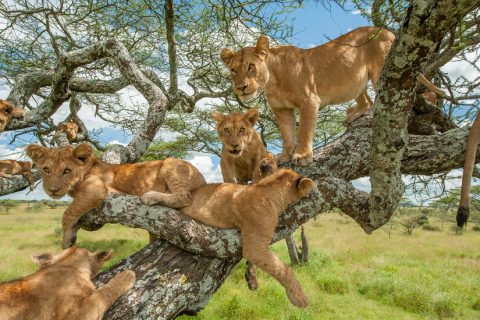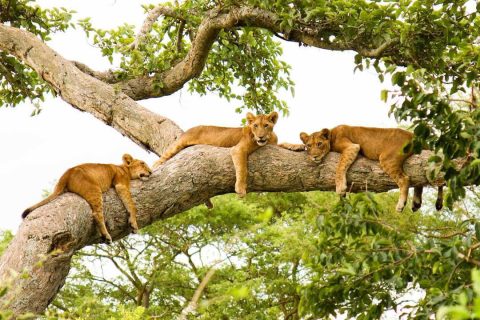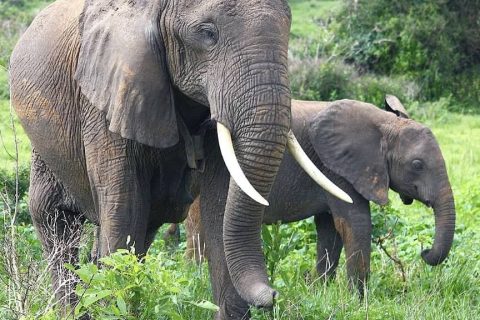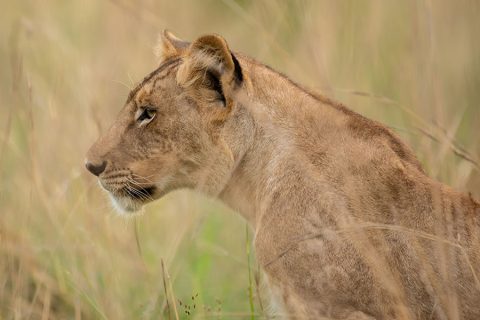Queen Elizabeth National Park
Queen Elizabeth National Park, Uganda
Queen Elizabeth National Park; located in western Uganda, is a destination that epitomizes the diverse beauty of Africa’s wilderness. Named after Queen Elizabeth II to commemorate her visit in 1954, this park is Uganda’s most visited national park and a premier safari destination. Spanning over 1,978 square kilometers, the park offers an array of ecosystems, ranging from sprawling savannas to lush wetlands, making it a haven for wildlife safaris in Uganda and an unforgettable experience for visitors. Managed by Universal Africa Safaris, a tour through Queen Elizabeth National Park is your gateway to exploring Uganda’s rich natural heritage.
A Brief History of Queen Elizabeth National Park
Established in 1952, Queen Elizabeth National Park was originally known as Kazinga National Park before being renamed in honor of Queen Elizabeth II. The park’s history is deeply intertwined with Uganda’s colonial past and the conservation efforts that followed independence. Over the decades, the park has been a focal point for wildlife conservation in Uganda, with various initiatives aimed at protecting endangered species and restoring habitats.
Geography and Location
Queen Elizabeth National Park is situated in the western region of Uganda, straddling the districts of Kasese, Kamwenge, Rubirizi, and Rukungiri. The park lies within the Albertine Rift Valley, an area renowned for its rich biodiversity and striking landscapes. The park is bordered to the north by the Rwenzori Mountains, often referred to as the “Mountains of the Moon,” and to the west by Lake Edward, which forms part of the border with the Democratic Republic of Congo. The diverse geography includes savannas, forests, and wetlands, making it a microcosm of Uganda’s natural beauty.
Wildlife in Queen Elizabeth National Park
Queen Elizabeth National Park is home to an astonishing variety of wildlife. The park is famous for its tree-climbing lions, which are often spotted lounging in the fig trees of the Ishasha sector. The savanna plains are teeming with large herds of buffalo, elephants, and antelope species such as Uganda kob and topi.
Hippos and crocodiles abound in the Kazinga Channel, which links Lake George and Lake Edward. The park is also a haven for birdwatchers, with over 600 bird species recorded, including the rare shoebill stork and the African fish eagle.
The Famous Tree-Climbing Lions of Ishasha
One of the most unique attractions of Queen Elizabeth National Park is the population of tree-climbing lions found in the Ishasha sector. Unlike most lions, which prefer to stay on the ground, these lions have adapted to spending time in the branches of large fig trees. This behavior is believed to help them escape the heat of the savanna and avoid biting insects. The sight of these majestic animals perched in trees is a highlight of any visit to the park and a rare phenomenon in the world of wildlife.





Activities in Queen Elizabeth National Park
Birdwatching Paradise
With its vast array of habitats, Queen Elizabeth National Park is a birdwatcher’s paradise. The park’s bird list is one of the highest in East Africa, with species ranging from waterbirds to forest dwellers. The Kazinga Channel is particularly rich in birdlife, where you can spot species such as the African skimmer, pink-backed pelican, and saddle-billed stork. The Maramagambo Forest, located within the park, is home to the forest flycatcher, white-naped pigeon, and the striking black bee-eater. Whether you’re a seasoned birder or a casual enthusiast, the diversity of bird species in Queen Elizabeth National Park is sure to impress.
The Kazinga Channel: A Wildlife Corridor
The Kazinga Channel, a natural waterway connecting Lake George and Lake Edward, is one of the park’s most prominent features. The channel is a magnet for wildlife, especially during the dry season when animals converge here to drink. A boat cruise on the Kazinga Channel offers an unparalleled opportunity to observe large concentrations of hippos, crocodiles, and a variety of bird species at close range. The cruise also provides spectacular views of the surrounding landscape, with the Rwenzori Mountains as a dramatic backdrop.
Uganda Tour Packages
3 Days Lake Mburo National Park Wildlife Safari
Book this 3 Days Lake Mburo National Park Wildlife Safari for the…
3 Days Murchison Falls National Park Safari
Enjoy this 3 Days Murchison Falls National Park Safari on Uganda’s largest…
3 Days Queen Elizabeth National Park Safari
Enjoy our 3 Days Queen Elizabeth National Park Safari. Almost 100…
4 Days Gorilla Trekking Bwindi & Chimpanzee Tracking Kibale
Our 4 Days Gorilla Trekking Bwindi and Chimpanzee Tracking Kibale…
3 Days Gorilla Habituation Experience in Bwindi
Overview of 3 Days Gorilla Habituation Experience in Bwindi Our…
1 Day Ngamba Island Chimpanzee Tour
Ngamba Island situated on a 95 hectare of forested Island…
1 Day Jinja Tour Experience
Arguably the beating heart of Uganda, Jinja is a marvel…
Kampala City Tour | 1 Day Tour Excursion
Soon after breakfast, your Kampala City Tour will start with…
3 Day Safari to Queen Elizabeth National Park
This tour will pass through Queen Elizabeth National Park, home…
Chimpanzee Tracking in Kyambura Gorge
Kyambura Gorge, often referred to as the “Valley of Apes,” is a verdant, steep-sided valley located on the eastern edge of Queen Elizabeth National Park. The gorge is home to a population of chimpanzees, and tracking these primates is one of the park’s most thrilling activities. The trek through the forested gorge is challenging but rewarding, offering the chance to see not only chimpanzees but also other primates, birds, and unique plant species. The experience of encountering chimpanzees in their natural habitat is a highlight for many visitors to the park.
Exploring the Crater Lakes
Queen Elizabeth National Park is dotted with a series of crater lakes, each offering its own unique scenery and wildlife. The Katwe Explosion Crater is the most famous, known for its panoramic views and salt production. Lake Katwe, in particular, has been a center for salt extraction for centuries, with local communities continuing the traditional methods of harvesting salt. A visit to the crater lakes offers not only stunning landscapes but also insight into the local culture and economy.
Cultural Encounters in Queen Elizabeth National Park
Beyond its natural wonders, Queen Elizabeth National Park is also a place of rich cultural heritage. The surrounding communities, including the Bakonzo, Banyankole, and Basongora, have deep connections to the land and its resources. Visitors can engage in cultural tours that offer insights into traditional practices, such as cattle herding, salt mining, and local crafts. These encounters provide a deeper understanding of the relationship between the park and the people who live around it, highlighting the importance of community-based conservation.
Best Time to Visit Queen Elizabeth National Park
The best time to visit Queen Elizabeth National Park is during the dry seasons, from June to September and December to February. During these months, wildlife is easier to spot as animals gather around water sources, and the roads within the park are more accessible. However, the park is open year-round, and even the wet seasons offer unique experiences, such as lush green landscapes and fewer tourists. Birdwatching is particularly rewarding during the wet seasons, when migratory species are present.
Accommodation Options in Queen Elizabeth National Park
Queen Elizabeth National Park offers a wide range of accommodation options, catering to different budgets and preferences. Luxury lodges such as Mweya Safari Lodge and Kyambura Gorge Lodge provide comfort and stunning views, while mid-range options like Enganzi Game Lodge offer great value. For budget travelers, there are several campsites and basic lodges within and around the park. No matter where you stay, the proximity to nature and the sounds of the wild make for an unforgettable experience.
How to Get to Queen Elizabeth National Park
Queen Elizabeth National Park is easily accessible by both road and air. The park is located approximately 400 kilometers from Kampala, Uganda’s capital, and the drive takes about 7-8 hours. The route passes through several towns, including Mbarara and Kasese, offering a glimpse of Uganda’s countryside. For those short on time, daily flights are available from Entebbe International Airport to Mweya Airstrip, located within the park. The flights offer a quick and scenic way to reach the park.
What to Pack for Your Safari
When preparing for a safari in Queen Elizabeth National Park, it’s important to pack appropriately. Essentials include:
- Lightweight, long-sleeved clothing to protect against the sun and insects.
- Sturdy hiking boots for walking safaris and chimpanzee tracking.
- Binoculars for birdwatching and spotting distant wildlife.
- A good camera with extra batteries and memory cards to capture the stunning scenery and wildlife.
- Sunscreen, hat, and sunglasses to protect against the sun.
- Insect repellent to keep mosquitoes and other insects at bay.
Challenges and Conservation Efforts
Queen Elizabeth National Park faces several challenges, including human-wildlife conflict, poaching, and habitat degradation. The park’s proximity to densely populated areas means that interactions between wildlife and humans are common, leading to conflicts over land and resources. Conservation efforts in the park focus on community engagement, anti-poaching initiatives, and habitat restoration. By visiting the park and supporting responsible tourism practices, travelers can contribute to these ongoing conservation efforts.
Conclusion
Queen Elizabeth National Park is a microcosm of Uganda’s natural and cultural wealth. From its iconic tree-climbing lions to the bird-rich Kazinga Channel, the park offers an array of experiences that cater to all types of travelers. Whether you’re exploring the diverse ecosystems, tracking chimpanzees in Kyambura Gorge, or learning about the local cultures, Queen Elizabeth National Park promises an adventure that will leave you with lasting memories. With Universal Africa Safaris, your journey through this incredible park will be not only memorable but also impactful, contributing to the conservation of one of Africa’s most treasured landscapes.
FAQs
1. What is the best time of year to see the tree-climbing lions in Queen Elizabeth National Park?
The dry seasons (June to September and December to February) are the best times to see the tree-climbing lions, as the weather is favorable, and wildlife is easier to spot.
2. How long does a typical safari in Queen Elizabeth National Park last?
A typical safari in Queen Elizabeth National Park lasts between 2 to 4 days, allowing time to explore the main attractions such as the Kazinga Channel, Ishasha sector, and Kyambura Gorge.
3. Are there any age restrictions for chimpanzee tracking in Kyambura Gorge?
Yes, the minimum age for chimpanzee tracking in Kyambura Gorge is 15 years old. This is due to the physical demands of the trek and the need to minimize disturbances to the chimpanzees.
4. What is the significance of the Kazinga Channel in Queen Elizabeth National Park?
The Kazinga Channel is a vital water source that attracts a large concentration of wildlife, making it one of the best spots in the park for game viewing and birdwatching. It also serves as a natural habitat for hippos and crocodiles.
5. How can I support conservation efforts in Queen Elizabeth National Park?
You can support conservation efforts by choosing responsible tour operators like Universal Africa Safaris, participating in community-based tourism activities, and contributing to conservation programs or donating to organizations working in the park.
